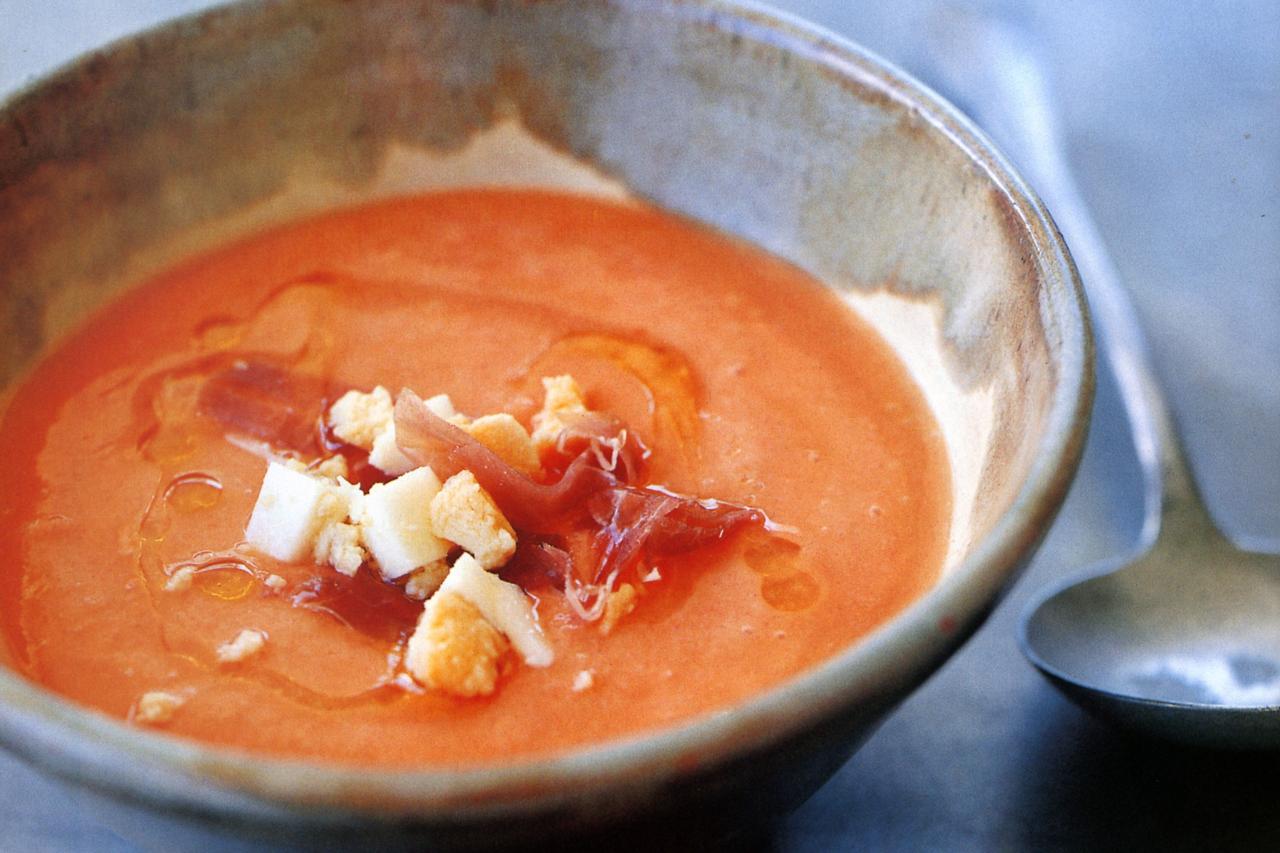During a sun-drenched sojourn to the heart of Spain, where history and culture blend as seamlessly as the ingredients in its cuisine, I was enchanted by Salmorejo, a velvety cold soup that epitomizes Spanish summer in a bowl. This delightful dish, with its rich red hue and refreshing taste, became a revelation. The core ingredients – ripe tomatoes, boiled eggs, and finely chopped Serrano ham – create a vibrant tapestry of flavors. Tomatoes offer a lush, fruity base, complemented by the creamy texture of the eggs and the savory depth of the ham, culminating in a dish that is both nourishing and indulgently flavorful. Motivated by this culinary discovery, I embarked on a mission to recreate Salmorejo at home. This journey through blending, tasting, and seasoning ended in triumph, enabling me to capture the essence of my Spanish adventure in every spoonful. It’s with great excitement and a dash of pride that I now share this Salmorejo recipe, inviting you to bring a taste of Spanish elegance to your table.

Salmorejo
Equipment
- 1 big saucepan
Ingredients
- 2 hard-boiled eggs
- Diced serrano ham
- A splash of sherry vinegar
- A pinch of salt
- 1 cup extra virgin olive oil
- 1 clove of garlic
- 1 medium baguette
- 8 medium tomatoes
Instructions
- Bring a big saucepan of salted water to a boil on the stovetop.
- After the water has to a boil, add the tomatoes and cook for 30-60 seconds.
- Remove the seeds from the tomatoes and mix.
- Blend in the splashes of vinegar, pepper, and onion until the soup is smooth and the bread has broken down entirely.
- Blend in 1 hardboiled egg until fully combined.
- Taste and adjust the salt, vinegar, onion, and bread to your liking.
Cooking tips about Salmorejo

- Use Ripe Tomatoes: The foundation of a great Salmorejo is ripe, juicy tomatoes. Their quality and taste significantly impact the final dish. Choose the freshest, most flavorful tomatoes you can find, as they provide the necessary sweetness and acidity.
- Bread is Essential: Traditional Salmorejo uses day-old white bread to thicken the soup and give it its characteristic creamy texture. Remove the crusts for a smoother finish and soak the bread in a little water or tomato juice to soften before blending.
- Quality Extra Virgin Olive Oil: The olive oil emulsifies with the tomatoes and bread, contributing to the creamy texture and adding depth to the soup’s flavor. Use the best extra virgin olive oil available to you, preferably a fruity variety for an authentic Andalusian taste.
- Garlic, Adjusted to Taste: Garlic adds a kick but can overwhelm the dish if used excessively. Start with a small amount, tasting and adding more as needed. For a milder garlic flavor, remove the germ in the middle of the clove.
- Season Properly: Along with salt, a dash of vinegar balances the sweetness of the tomatoes and enhances the overall flavor profile of Salmorejo. Sherry vinegar is a traditional choice that offers a subtle nuttiness.
- Chill Before Serving: Salmorejo is best served cold, especially on hot summer days. Allow it to chill in the refrigerator for at least a couple of hours. This not only cools the soup but also lets the flavors meld together beautifully.
- Garnishes Matter: Salmorejo is typically topped with hard-boiled eggs, finely chopped, and pieces of Serrano ham, providing texture contrasts and savory notes. Consider adding a drizzle of olive oil and a sprinkle of black pepper before serving for an added touch of elegance.
- Blending for Smoothness: For a silky texture, blend the ingredients thoroughly until completely smooth. If desired, pass the mixture through a sieve to ensure there are no remaining bits, achieving that velvety consistency symbolic of a perfect Salmorejo.
Serving suggestions about Salmorejo

- As a Starter or Light Lunch: Serve Salmorejo chilled in small bowls as a refreshing starter for a summer meal or as the centerpiece of a light lunch. Its creamy texture and vibrant flavor make it an ideal way to begin a dining occasion or stand alone on warmer days.
- With Traditional Toppings: Garnish your Salmorejo with finely chopped hard-boiled eggs and thin strips of Serrano ham. These traditional toppings add a savory depth and contrasting textures that complement the smoothness of the soup perfectly.
- Drizzle of Olive Oil: Before serving, drizzle a high-quality extra virgin olive oil over the soup. The fruity notes of the olive oil enhance the tomato base, creating a harmony of flavors that is quintessentially Spanish.
- Fresh Bread on the Side: Offer slices of crusty white bread or baguette on the side. The bread acts as the perfect accompaniment for dipping into the soup, absorbing its flavors while adding a satisfying crunch.
- Wine Pairing: Pair Salmorejo with a light and crisp Spanish white wine, such as Albariño or Verdejo. The acidity and fruitiness of the wine balance the richness of the soup, providing a delightful gastronomic experience.
- Offer as Part of a Tapas Spread: For an authentic Spanish dining experience, serve Salmorejo alongside other tapas dishes, such as Patatas Bravas, Croquetas, and Manchego cheese. This allows guests to enjoy a variety of tastes and textures, embodying the spirit of Spanish cuisine.
- Garnish with Fresh Herbs: A sprinkle of freshly chopped parsley or chives adds a burst of color and a touch of freshness that elevates the overall appearance and taste of the dish.
Top 5 FAQs about Salmorejo

- What is Salmorejo? Salmorejo is a traditional Spanish cold soup, originating from Andalusia, that’s known for its thick, creamy consistency and vibrant red color. It’s made primarily from ripe tomatoes, bread, extra virgin olive oil, garlic, and vinegar, blended together to create a refreshing yet deeply flavorful dish, often served as a cool embrace during warm summer days.
- What makes Salmorejo different from Gazpacho? While both Salmorejo and Gazpacho are popular Spanish cold soups made with tomatoes, Salmorejo is thicker due to a higher ratio of bread in the recipe, which gives it a creamier texture. Additionally, Salmorejo typically has fewer ingredients and is garnished with hard-boiled eggs and Serrano ham, providing a contrast of textures and flavors that distinguish it from Gazpacho.
- What are the key ingredients in Salmorejo? The quality and freshness of a few key ingredients are paramount in making Salmorejo. These include ripe, juicy tomatoes for the base; day-old white bread to thicken and give it a creamy texture; extra virgin olive oil for a velvety smoothness and rich flavor; garlic for a subtle kick; and vinegar, usually sherry vinegar, to brighten the soup with its acidity.
- How should Salmorejo be served? Salmorejo is best served chilled, making it an ideal appetizer or light meal during the hot summer months. It’s traditionally garnished with hard-boiled eggs and thinly sliced Serrano ham, but variations might also include a drizzle of extra virgin olive oil and a sprinkle of black pepper to enhance its flavors right before serving.
- Can Salmorejo be made in advance? Yes, Salmorejo can and should be made in advance to allow it to chill thoroughly in the refrigerator and let the flavors meld together beautifully. It’s a perfect make-ahead dish for easy entertaining or enjoying a quick, refreshing meal at home.

Leave a Reply